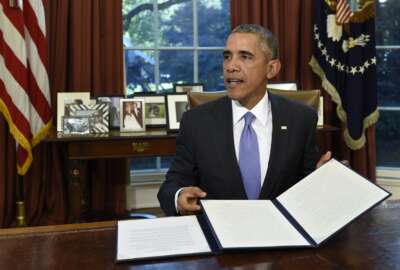
Congress cuts readiness increases in NDAA
Congress decided yesterday what programs will get a haircut in freeing up $5 billion in defense spending. Among the programs is the Long Range Strike Bomber and...
CORRECTION: A previous version of the article incorrectly stated the details of the Long Range Strike Bomber. The bill is reaping $230 million not used because the contract was awarded later in the year.
House Armed Services Committee Chairman Mac Thornberry (R-Texas) said there would be pain for important programs when cutting $5 billion from the National Defense Authorization Act. That pain came in the form of equalizing military service readiness and Defense Department’s technology offset initiative increases and upping the amount of planned department headquarters streamlining for fiscal year 2016 to save money.
A total of $250 million was taken from the Army’s readiness increase and close to $200 million from the Air National Guard’s readiness increase, according to a document obtained by Federal News Radio.
A $100 million increase to DoD’s technology offset initiative — announced last year to beef up the United States’ technological superiority to adversaries — was erased in order to cut the deficit.
The bill will also save $230 million from the Air Force’s new Long Range Strike Bomber, the funds are saved from money that was not used because of a delay in the award of the contract. The almost $60 billion contract was awarded to Northrop Grumman last week.
Other cuts include a $50 million reduction in the purchase of short and medium range anti-ballistic missile systems and a $30 million reduction in the purchase of SM-3 1B anti-ballistic missiles.
“There are real programs, real capability, that has to be cut to reach the $5 billion. Fewer things we can buy, things we’ve got to slow down, so it is into the meat,” Thornberry said during a Nov. 2 speech at the Defense One Summit in Washington.
Budget deal forces Congress to cut deep
House and Senate authorizers and appropriators were forced to cut $5 billion from the defense authorization bill after the White House and Congress reached a budget deal that raised both the domestic and defense sequestration caps for the next two years.
The agreement allowed for $545 billion in defense base budget spending and another $59 billion in overseas contingency operations spending (OCO). OCO is meant for emergency war funding and is not applicable to sequestration caps.
The total adds up to $607 billion, $5 billion short of the originally approved $612 billion in the defense authorization bill.
Thornberry said he thought the two-year deal was more important than the $5 billion in defense spending. The deal gives more certainty to the Defense Department and military services in their planning.
“That allows us to do our job of building the military. To dig down deeper into those tradeoffs that need to be made,” Thornberry said.
Congress figured out the details of the cuts during a meeting on Monday. A majority of the cuts came from reductions not previously carried in the defense bill. Those include $103 million in classified programs, cuts in F-15 modifications and a delay in the Next Generation Jammer development program. Other savings in the category came from unexecutable civilian full-time equivalent targets.
About $1 billion of the cuts came from funds Congress added to the bill, which the President did not request in his budget. Those include the readiness increase cuts, the technology offset cut and $70 million in basic research spread over the military services.
Another $700 million of the cuts came from increases to reductions in the bill. A majority of that number came from fiscal year 2016’s share of planned DOD headquarters streamlining. Other reductions came from the Distributed Common Ground System-Army, common computer resources and F-18 modifications.
More than $1 billion was able to be saved through fuel rate adjustments because of the drop in fuel prices. Also, the OCO fund saved $125 million from the defunct Syria train and equip program.
President Barack Obama vetoed the defense authorization bill over the way OCO was used to bolster defense spending without increasing domestic spending.
The budget deal seems to have taken care of that problem and given new life to the bill.
Thornberry said the House is still set to vote on overriding that veto on Nov. 5 and the legislative body was in the “ballpark” of enough votes.
Both the House and Senate must have two-thirds of their members vote to override the veto. The Senate passed the bill with more than two-thirds, but the House did not.
Copyright © 2025 Federal News Network. All rights reserved. This website is not intended for users located within the European Economic Area.
Scott Maucione is a defense reporter for Federal News Network and reports on human capital, workforce and the Defense Department at-large.
Follow @smaucioneWFED





